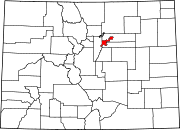
Denver is a consolidated city and county, the capital, and most populous city of the U.S. state of Colorado. Its population was 715,522 at the 2020 census, a 19.22% increase since 2010. It is the 19th-most populous city in the United States and the fifth most populous state capital. It is the principal city of the Denver–Aurora–Lakewood metropolitan statistical area, the most populous metropolitan statistical area in Colorado and the first city of the Front Range Urban Corridor.
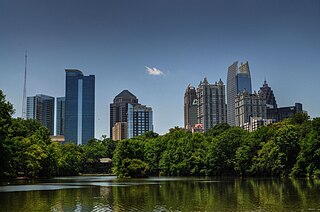
Midtown Atlanta, or Midtown, is a high-density commercial and residential neighborhood of Atlanta, Georgia. The exact geographical extent of the area is ill-defined due to differing definitions used by the city, residents, and local business groups. However, the commercial core of the area is anchored by a series of high-rise office buildings, condominiums, hotels, and high-end retail along Peachtree Street between North Avenue and 17th Street. Midtown, situated between Downtown to the south and Buckhead to the north, is the second-largest business district in Metro Atlanta. In 2011, Midtown had a resident population of 41,681 and a business population of 81,418.

Denver Union Station is the main railway station and central transportation hub in Denver, Colorado. It is located at 17th and Wynkoop Streets in the present-day LoDo district and includes the historic station house, a modern open-air train shed, a 22-gate underground bus station, and light rail station. A station was first opened on the site on June 1, 1881, but burned down in 1894. The current structure was erected in two stages, with an enlarged central portion completed in 1914.
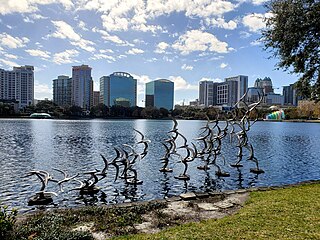
Downtown Orlando is the historic core and central business district of Orlando, Florida, United States. It is bordered by Marks Street in the north, Mills Avenue in the east, Orange Blossom Trail in the west, and Kaley Avenue in the south. There are several distinct neighborhoods in downtown; "North Quarter" to the north, "Lake Eola Heights Historic District" just north of Lake Eola, "South Eola" contains Lake Eola Park and continues to the east and south of Lake Eola, "Thornton Park" in the east, "Parramore" in the west, "Lake Cherokee Historic District" to the south, and the "Central Business District" between Colonial Drive and Lake Lucerne in the center. In 2010, the estimated population of downtown was 18,731. The daytime population was estimated to be 65,000. The 5-mile radius population of downtown is 273,335.

The U Street Corridor or Greater U Street, sometimes known as Cardozo/Shaw, is a neighborhood in Washington, D.C., located in Northwest D.C. Centered along U Street, the neighborhood is one of Washington's most popular nightlife and entertainment districts, as well as one of the most significant African American heritage districts in the country.

While Denver may not be as recognized for historical musical prominence like such cities as Los Angeles, Detroit, Chicago or New York City, it still manages to have a very active popular, jazz, and classical music scene, which has nurtured many artists and genres to regional, national, and even international attention. Though nearby Boulder, Colorado has its own very distinct music scene, they are intertwined and often artists based there also play in Denver.

The Colorado Convention Center (CCC) is a multi-purpose convention center located in Downtown Denver, Colorado. At 2,200,000 square feet it is currently the 12th largest convention center in the United States. It opened in June 1990; the first event being the NBA draft for the Denver Nuggets. The convention center was expanded in 2004 to include several meeting rooms, two ballrooms and an indoor amphitheater. Since opening, the center hosts an average of around 400 events per year. Centrally located in the city, it has become one of Denver's many landmarks due to its architecture and is adjacent to the Denver Performing Arts Complex and is just blocks away from the Colorado State Capitol, Auraria Campus and the 16th Street Mall. The CCC is directly served via light rail by RTD's Theatre District–Convention Center station.
Indianapolis has seven designated neighborhoods as Cultural Districts, first established in 1999: Broad Ripple Village; Mass Ave; Fountain Square; Wholesale District; Canal and White River State Park; Indiana Avenue; and Market East. The purpose of these designations was to capitalize on cultural institutions within historically significant neighborhoods unique to the city's heritage for economic development and revitalization.

30th & Downing station is a RTD light rail station in the Five Points neighborhood of Denver, Colorado, United States. Originally operating as part of the D Line, the station was opened on October 8, 1994, and is operated by the Regional Transportation District. It is the current northern terminus for Five Points trains. Currently there is only one track on Welton Street for light rail trains, necessitating track sharing for trains in both directions between here and 20th & Welton. Therefore, only one line serves this station and all stations on the Five Points branch.

Lincoln Park is a neighborhood and public park close to downtown Denver, Colorado and the location of the Art District on Santa Fe. The neighborhood is one of Denver's oldest and is just to the south of the area where Denver was first settled in the 1850s. Many houses date from about 1900. The neighborhood is sometimes called "La Alma/Lincoln Park" or the West Side.
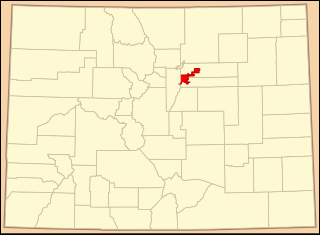
Central Park, previously Stapleton, is a neighborhood within the city limits of Denver and Aurora, Colorado. Located east of downtown Denver, the neighborhood is at the former site of the decommissioned Stapleton International Airport, which closed in 1995. It is the largest residential neighborhood within the city of Denver. The Central Park Neighborhood contains twelve specifically named sub-neighborhoods, 11 public/private schools, 50 parks, 7 pools, several shopping and business districts, a city of Denver recreation center, and a Denver library. The latest population as of 2022 is estimated at 30,000.

The A Line is a Regional Transportation District (RTD) commuter rail line serving Denver and Aurora, Colorado, operating between downtown Denver and Denver International Airport (DIA). During planning and construction, it was also known as the East Rail Line, but most locals refer to it as the A Line. Despite its former title, the line does not serve the campuses of the University of Colorado.
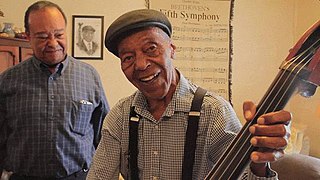
Charles Burrell is a classical and jazz bass player most prominently known for being the first African-American to be a member of a major American symphony. For this accomplishment he is often referred to as "the Jackie Robinson of Classical Music".

25th & Welton station is a RTD light rail station in Denver, Colorado, United States. Originally operating as part of the D Line, the station was opened on October 8, 1994, and is operated by the Regional Transportation District. Located in the Five Points neighborhood, it is the stop closest to the Blair-Caldwell African American Research Library. The January 14, 2018, service changes introduced the L Line, which now serves this station in place of the D Line.

27th & Welton station is a RTD light rail station in the Five Points neighborhood of Denver, Colorado, United States. Originally operating as part of the D Line, the station was opened on December 19, 1995, and is operated by the Regional Transportation District. The stop was opened over a year after the rest of light rail line after support from the neighborhood. The January 14, 2018, service changes introduced the L Line, which now serves this station in place of the D Line.

29th & Welton station was an RTD light rail station in the Five Points neighborhood of Denver, Colorado, United States. Formerly operating as part of the D Line, the station was opened on October 8, 1994, and was operated by the Regional Transportation District.

The L Line is a light rail line which is part of the light rail system operated by the Regional Transportation District in the Denver–Aurora Metropolitan Area in Colorado. The L Line opened as part of a service change in 2018 and is formed by a truncated section of the D Line, which formerly served the route.

Fitzsimons station is a Regional Transportation District (RTD) light rail station on the R Line in Aurora, Colorado. The station is located along the north side of Fitzsimons Parkway along Sand Creek Park and serves the University of Colorado Anschutz Medical Campus via a free shuttle bus.
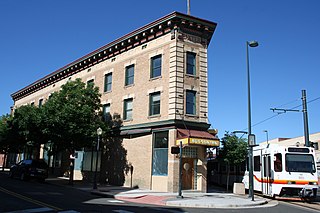
The Rossonian Hotel, is a historic building and former business located at 2650 Welton Street in the Five Points section of Denver, Colorado, United States. It is listed on the National Register of Historic Places since in 1995, for ethnic heritage and social history. It has also been known as the Baxter Building and as the Baxter Hotel.
George Louis Bettcher (1862–1952) was an American architect based in Denver, Colorado. He designed a number of buildings which survive and are listed on the National Register of Historic Places for their architecture.





















